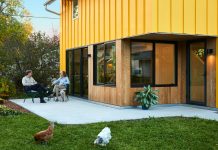Architects John Dwyer and Laura Cayere-King left this week for Puerto Rico.
John Dwyer just took off for Puerto Rico, packing four 70-pound bags of supplies including diapers, baby wipes and bottled water for citizens of the storm-ravaged country. The Minneapolis architect (D/O) and program manager/instructor in the architecture program at the Dunwoody College of Technology is traveling with Laura Cayere-King, project manager/project designer at Peterssen/Keller Architecture, on a relief mission of sorts.

Except “communication with the country is terrible,” Dwyer said before leaving. “We don’t what conditions we’re walking into. We’re going in blind. But, presumably, it’ll be housing related. We assume, at some point, we’ll be designing and building stuff. But we’ll see.”
Dwyer’s done this before. In 2007, following Hurricane Katrina, Dwyer traveled to New Orleans to establish a community design studio in the Lower Ninth Ward funded by United Way and Architects for Humanity. The studio provided pro bono architectural services to families who lost their homes to a storm surge that breached the city’s canal levees and triggered the worst engineering disaster in U.S. history. For a video on the studio’s work, go here.
The situation in Puerto Rico, following Hurricane Maria, may be worse. Through the St. Paul Foundation’s El Fondo Boricua Hurricane Maria Relief Fundraiser, Dwyer’s been raising money to benefit Ponce Neighborhood Housing Services in Ponce, Puerto Rico. He and Cayere-King will be meeting with the neighborhood housing organization “to understand how we can best help as architects,” he says.

What he learned from the New Orleans experience is to “go in and lead with our ears. We have to listen and respond directly to the need. Not bring another agenda in.” Nonetheless, Dwyer has hopes. They include: making concrete contributions, “whether that’s providing data, doing mapping, assessing damage, or providing tools for a roadmap for rebuilding over the next decade.” He also wants to “start helping with a long-term plan for what the community envisions becoming and what role we could play.”
He anticipates they’ll have “a small set of immediate projects we can start for rebuilding. We don’t know what they are yet. We want to really listen and make sure we’re responding to their needs. We want to help preserve the culture, which is the people.” He also hopes to establish a studio in which Dunwoody students would travel to Ponce to do the necessary design and construction work, which in turn would become part of a larger initiative at Dunwoody on public interest design. “We’ve already started to establish funding for students to do that,” he says.



















